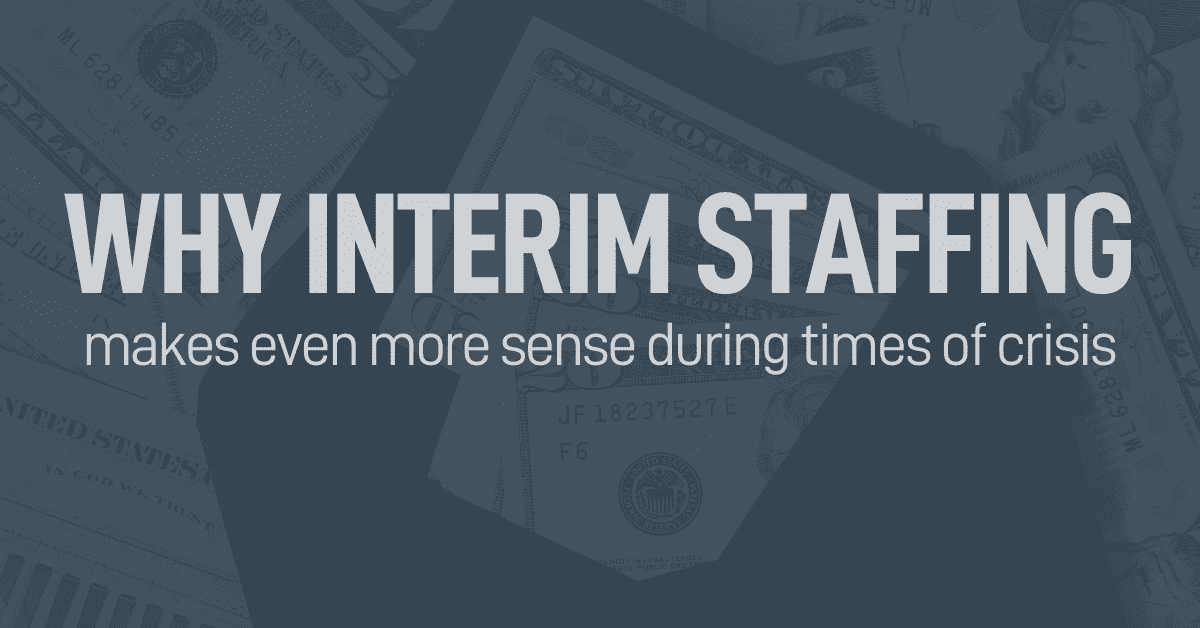Why Interim Staffing Makes Even More Sense During Times of Crisis

A brief review of the history of interim staffing throws light on the evolution of the industry. Three “black swan” events were major disruptors that contributed to the thriving business it is today, according to Tim Ozier, Sr. Director of Sales at MRINetwork:
- Y2K in 1999. “I guess this wasn’t a true ‘black swan’ event in that it was predictable, but it caused massive turmoil and disruption for companies all over the world. It was a super-charging event for contract/interim staffing,” says Ozier. “Companies needed IT expertise to manage the challenging transition, and this transformed the sector from supplying primarily lower-level employees to engaging high-level IT professionals. That was the start, and it’s never slowed down.”
- Recession of 2008. As the recession lingered, companies were faced with the painful process of laying off thousands of permanent employees. “It was expensive, lowered morale, and it created bad publicity,” recalls Ozier. “But many of these companies came out of the recession with greater profitability because of the reduction in fixed costs such as benefits, vowing that they were not ever going to go through this again.” They reassessed their talent access strategy, opting for enough full-time people to cover baseline business and supplemented by contractors that allowed them to flex up or down as needed.
- COVID-19. The inherent flexibility of interim staffing is a lifeline for companies that have had to change the way they do business to survive during the pandemic. “Today’s contractors are high-level and greatly needed, so the coronavirus has had much less of a negative impact on the sector,” says Ozier. “IT has been the least impacted, and other industries have experienced a rise in the use of contractors, notably insurance and logistics.”
Integrating interim staffing into a talent access strategy is always smart, but the current economic climate makes it even more so. Committing to new, full-time employees without the ability to meet them in person during the pandemic can be unnerving, so this is a good time to make interim staffing a key element of your talent access strategy. “You can start the candidate as a contractor until travel is allowed for in-person interviewing,” advises Ozier. “It also allows the potential employee to check out you and your company over the course of the interim contract.”
In reassessing their current skill sets at this time, many companies have discovered that they need to bring different strengths to their leadership teams. Factors like remote working and economic and labor market changes are shifting priorities and may require different approaches. “Often, the right interim employees can help forge solutions to the challenges a company faces in the midst of a crisis like the pandemic,” says Ozier. “They bring fresh ideas to the table while helping teams to become more adaptable and innovative.”
Aside from taking care of immediate duties, deploying contract employees can encourage companies to broaden their comfort zone to change things that are no longer working and find new ways of doing them. They are accustomed to coming into a new environment and quickly assessing what needs to be done and creating a plan for accomplishing it. Although there’s no handbook for dealing with a pandemic, their past experience as contractors helps to hone their problem-solving skills.
“Implementing a flexible staffing strategy that includes contract employees in the mix – no matter what industry you’re in – is a key component of dealing with the current crisis,” Ozier believes. “Companies can cost-effectively staff up or down — and back up or down again — to meet the challenges of the rapidly changing business landscape.”

